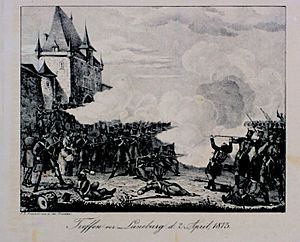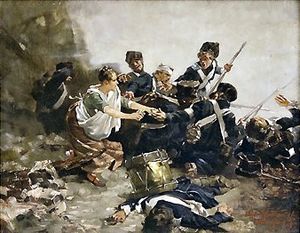Battle of Lüneburg facts for kids
Quick facts for kids Battle of Lüneburg |
|||||||
|---|---|---|---|---|---|---|---|
| Part of the German campaign of the Sixth Coalition | |||||||
 |
|||||||
|
|||||||
| Belligerents | |||||||
| Commanders and leaders | |||||||
| Units involved | |||||||
| Strength | |||||||
| 3,100, 6 guns | 2,800, 9 guns | ||||||
| Casualties and losses | |||||||
| 300 killed and wounded | 2,300 captured, 9 guns, 3 flags | ||||||
The Battle of Lüneburg happened on April 2, 1813. In this fight, the Allied forces from Russia and Prussia won against a French and Saxon army. This battle was the first big fight after the French army, led by Napoleon, had to retreat from Russia. It was very important because it gave hope to the German people. It was the first victory for the Allies in what became known as the "wars of liberation."
Contents
Why the Battle Happened
After Napoleon's army was defeated in Russia in 1812, many people in northern Germany were very angry at France. This feeling started in East Prussia in January 1813. It turned into a full rebellion when Prussia decided to turn against France in mid-February. Russian cavalry (soldiers on horseback) also started to move across the Oder River. By the end of February, this anger spread to cities like Hamburg, which France had taken over in 1810.
Big riots broke out in Hamburg on February 24. After seven people were quickly executed on March 2 and 3, the unrest grew even more. The French army left Hamburg on March 12, and the rebellion spread to Lübeck and Stade.
On March 14, a Russian cavalry leader named Friedrich Karl von Tettenborn arrived in Ludwigslust with 1,300 Cossacks and two cannons. He convinced Mecklenburg to switch sides from the Confederation of the Rhine to the Allies. He then pushed the French forces, led by General Joseph Morand, back across the Elbe River. On March 18, Tettenborn entered Hamburg. At the same time, Russian cavalry rode through Harburg, Stade, and Lüneburg, and the people celebrated them.
In this situation, on March 21, the citizens of Lüneburg, a town of 10,000 people, forced the French officials out of their city. They also started to form their own volunteer troops.
French Plans and Allied Movements
Napoleon ordered General Dominique Vandamme to gather 25,000 soldiers near the lower Weser River. His goal was to bring order back to the areas France had taken over. Vandamme arrived in Bremen on March 27. He told General Morand to go to Tostedt to fight against the rebels and Cossacks. These groups had to retreat to Hamburg.
Then, Morand received a new order: to lead a punishment mission against Lüneburg. In Lüneburg, armed citizens and Alexander von Benckendorff's Cossacks had already stopped General Wathier's troops from taking over the city on March 28.
As Morand's 34th Division moved further from Bremen, Cossacks from Benckendorff's Russian army surrounded and attacked them more and more. Wilhelm von Dörnberg, who was now a Russian general, was very good at organizing uprisings and small-scale battles. He was given the job of starting a general rebellion in the Hanover area. His attempt to cross the Elbe River near Werben on March 26 failed.
When it became clear that Lüneburg was Morand's target, the main commander of the Russian-Prussian armies, General Peter Wittgenstein, sent Dörnberg's army across the Elbe near Lenzen on March 31. This was to help the rebellious city. Dörnberg quickly moved towards Lüneburg from the southeast. He also sent some troops to Boizenburg to create a safe way to retreat if needed.
Who Fought in the Battle
Morand's 34th Division had about 2,800 soldiers and nine cannons. This included a small group of 75 cavalry soldiers, made up of dragoons, chasseurs, mounted customs officers, and gendarmes. The main part of his division was two battalions (out of three) from the Saxon infantry regiment "Prinz Maximilian" and a Saxon cannon unit.
Dörnberg's forces included an infantry battalion and a small cannon unit with four guns from the Prussian Borstell brigade. His Russian troops were a Jäger battalion, four squadrons of hussars, two dragoons, and the Benckendorff corps. The Benckendorff corps had three Cossack and one Bashkir platoon and two cannons. In total, Dörnberg had about 1,100 infantry soldiers and about 1,300 cavalry soldiers. Before the attack on Lüneburg, Alexander Chernyshyov's Russian patrol force joined them. Chernyshyov's group had 1,800 cavalry soldiers and four cannons.
The Battle Begins
On April 1, Morand attacked Lüneburg from the west. The armed citizens at the old city gates fought back in a messy way, but they were quickly defeated. Many were arrested. That evening, Morand ordered that fifty of them be shot the next day. On the same day, Dörnberg's army reached Lüchow, and Benckendorff's army reached Dannenberg. Both groups planned with Chernyshyov, whose cavalry had crossed the Elbe near Bählau on March 31 and were in Wustrow, to conquer Lüneburg on April 2.
When Cossacks appeared at the southern city gate at 6 AM, Morand thought they were just small patrols, like before. He sent two cannons with infantry protection and his 75 cavalry soldiers outside the city to chase the enemy away. But his troops walked right into one of Dörnberg's traps. They were surprised to be attacked from the side by many Russian hussars. They lost their cannons and were captured, except for some of the cavalry.
Only later in the morning did Morand realize that a strong Russian-Prussian army with infantry and cannons was attacking Lüneburg to take it over. Meanwhile, one city gate was already in the hands of Prussian soldiers called fusiliers, led by Major Karl von Borcke. While fighting broke out at other city gates, armed citizens freed those who were supposed to be shot. They also attacked enemy soldiers in the streets.
Morand, who was already wounded, lost control of the situation. At noon, he ordered a retreat from the city to a French force located west of the New Gate. But his soldiers could no longer follow his order. Some were trapped in different gates and buildings by the Prussian and Russian troops entering the city and were already starting to surrender.
Morand then tried to take the city back from the outside. This attack failed after some early success, and he was badly wounded again. It was during this time that Johanna Stegen, a young woman from Lüneburg, became famous. She bravely brought urgently needed ammunition to the Prussian fusiliers. She had found the ammunition in an abandoned wagon on the battlefield, risking her life.
In the afternoon, Russian cavalry surrounded Morand's troops. Dörnberg offered an honorable surrender, but the Saxon officers could not make the French stop fighting. After a failed attempt to break through and retreat to Reppenstedt, the Russian-Prussian cannons, now stronger with captured cannons, began to fire on the surrounded troops. Around 5 PM, Morand's entire force surrendered and was taken prisoner. The French-Saxon division was completely defeated. They lost 2,300 prisoners, 9 cannons, and 3 flags. The Allies lost 300 soldiers killed and wounded, including 46 Prussians.
What Happened Next
The very next day, the winners had to retreat. A large French division of 11,000 soldiers, led by Marshal Davout, was moving north on the left side of the Elbe River. Dörnberg's army crossed the Elbe near Boizenburg, taking the prisoners and many people who had fled Lüneburg, including Johanna Stegen. Morand died there on April 5 from his wounds.
Davout arrived in Lüneburg on April 4. He was surprisingly kind to the people. He only demanded money and that everyone give up their weapons. Dörnberg's and Tettenborn's earlier warnings might have helped. They had said that for every German civilian executed, a captured French soldier or official would be hanged. This might have stopped Davout from taking harsher actions.
When Vandamme left the area between the Elbe and Aller rivers in the following days, Dörnberg took over Lüneburg again on April 11. Only when Vandamme moved to conquer Hamburg in May did the Allies have to leave Lüneburg for a long time.
News of Morand's army being destroyed spread quickly in northern Germany. It brought great joy and confidence that the Allies would win. It was unusual that the news mentioned how Russian and Prussian soldiers worked together with armed citizens. For the first time, a woman was also mentioned as taking part in the fight.
This battle showed a new kind of war. On the Prussian side, it was no longer just professional soldiers fighting. This was clear from an article in the Vossische Zeitung about Georg Haase, the first volunteer soldier to die. His parents announced that their son died "for fatherland, German freedom, national honor and our beloved king." They added: "The loss of such a child is hard; but it is a comfort for us that we too were able to give birth to a son for the great holy purpose. We deeply feel the necessity of such sacrifices.”
Another new thing was the awarding of the first Iron Cross by King Frederick William III. This award was given to both officers and regular soldiers in the Prussian army. Major Borcke, along with many other officers and soldiers, received the Iron Cross 2nd Class.
Prussia presented itself as a leader in the fight for freedom. However, the role of Saxony, a state in the Rhine Confederation, in trying to stop the rebellion in northern Germany was seen badly. When the Saxon Foreign Minister Ludwig Senfft wanted Prussia and Russia to agree that Saxony would stay neutral in April, his negotiating partners pointed out that Saxon soldiers were fighting Prussians right in the streets of Lüneburg. For people at the time, the Battle of Lüneburg seemed like a perfect example of how the war was changing and what its outcome would be. German historians continued to remember this battle well into the 20th century.


